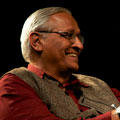Bunker Roy, Jehane Noujaim, Joia Mukherhjee, Kief Davidson, and Sally Osberg on the Celebrating Stories of Change panel. Photo by Jonathan Hickerson.
Bridgette Bates
For the last five years, Sundance Institute’s Documentary Film Program and the Skoll Foundation have partnered to showcase global innovative game-changers through film. This ongoing project, titled Stories of Change, has spanned the globe—both in search of stories to support, and also to participate in international convenings that shed light on these important stories, the most recent of which occurred at the Sundance Film Festival on Tuesday, where audiences got a sneak peek at a new crop of projects. These projects feature social entrepreneurs who offer creative solutions to some of the world’s most challenging issues, from poverty to health. But what was uniquely prevalent at this recent gathering was the powerhouse of women behind both the partnership, and the stories at hand.
Cara Mertes, director of the Documentary Film Program, kicked-off the Festival’s Stories of Change panel by describing the impact she hopes these films will have on society. “Ideas that today seem radical, tomorrow will seem like common sense” said Mertes. “If you can change the narrative, you can change the outcome.” Sally Osberg, the president and CEO of the Skoll foundation, proceeded to moderate the discussion between the two featured projects—bringing both the directors and the entrepreneur subjects to the stage.
The first project showcased was by director Kief Davidson, the director of Kassim the Dream and The Devil’s Miner, whose Stories of Change project is the Untitled Global Health Documentary. When Davidson first began to consider making this film, he worried that a story on global health would be incredibly unappealing to audiences. But after learning more about the work of Dr. Paul Farmer’s Partners in Health, Davidson reconsidered. “Healthcare as a human right is very personal and character-driven,” said the filmmaker, who sees character as the driving force behind documentaries. “When you move people emotionally, it transcends people every time. So for me, it’s trying to find the most compelling characters possible.”
He found that character in Dr. Joia Mukherjee, a trained infectious disease physician and a single mother who works for PIH, an international medical non-profit that sets up clinics across the world in places that no other organization wants to go from Haiti to Rwanda. As Davidson began to follow Mukherhjee, her own narrative turned when her son was diagnosed with cancer, which just reinforced her passionate belief that healthcare needs to be treated as a basic human right. She was present to share her story of how she was influenced as a child by seeing Leprosy patients in India, and how this grueling suffering of the poor stayed with her throughout her life.
For a doctor not used to being in the spotlight, Mukherjee was cautious about the “social narrative” of the film and how it portrayed PIH’s work. “The real talent and strength and resilience come from the people living it, who don’t speak English and can’t communicate in the same way. I’m afraid of the narrative of the great white hope—the elite saving the poor.” Although Mukherhjee is an inspiring entrée into the story, Davidson’s film focuses on the PIH’s groundbreaking approach to practicing medicine. They employ mostly locals. Mukherhjee described the most impressive part of this Story of Change, “We have a large team of 15,000 employees – 80% are rural poor people who had never before had a paying job. They now get a paycheck for helping the suffering.”
The next project featured was Jehane Noujaim’s Solar Momas. Noujaim is the award-winning director of Control Room and Startup.com and as soon as she heard of the work of Bunker Roy she knew she wanted to tell his story. “You always want to make films that change the world, but as a filmmaker you also want to entertain,” said Noujaim and she realized she had both facets in the story of Roy’s Barefoot College in India, which trains women from rural villages across the world to become solar engineers.
Roy described his upbringing in India as a young man receiving the best education possible. He was well on his way to a lucrative career, but the passion to do something meaningful was missing from a path into government or academics. Instead, he went to live in a village to learn usable skills, like building a well, when he realized he could teach villagers engineering skills to help improve their quality of life. But he quickly learned that if he trained men, they would leave the village to find better jobs; whereas the women would stay to care after the children. “The best way to get something done is not the television, not the telephone, not the telegraph, but tell-a-woman,” joked Roy.
When Noujaim teamed up with Roy to make a film, he was adamant that it not be focused on him, but on the journey of the women. “The journey is very dramatic and compelling. We focused on the Jordanian woman Rafea and you fall in love with her,” said the director. “It’s very emotional as you watch her overcome fear and walk out like a tiger.” Rafea’s story, like others in the film, show how women courageously leave behind their homes for a few months and travel to a foreign place to learn how to engineer solar power, so that they can teach their fellow villagers this skill, and their village can benefit from the energy resource.
This positive lesson in the power of community and common cause is central to all of the Story of Change projects. “As long as you can find a human story,” Noujaim said, “everyone can relate to being presented with an opportunity that you can change your life.” Osberg agreed: “That’s the theme of these films. We’re all on this journey – we’re all part of this story.”




